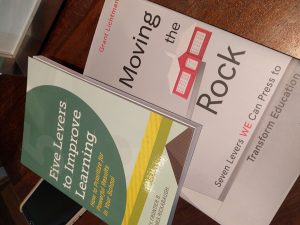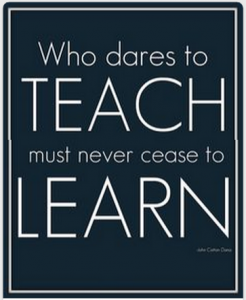 I took up this book in an effort to contribute understanding to a shared language around school transformation. This book, written by James Rickabaugh and Tony Frontier, was published in 2014, but much of what they say still has important implications to educational transformation, and the forces acting on education’s systems and structures. This book speaks to the work that we are all trying to do to improve learning for both students and educators.
I took up this book in an effort to contribute understanding to a shared language around school transformation. This book, written by James Rickabaugh and Tony Frontier, was published in 2014, but much of what they say still has important implications to educational transformation, and the forces acting on education’s systems and structures. This book speaks to the work that we are all trying to do to improve learning for both students and educators.
- You would be interested in this book if:
* You are anywhere on your journey of writing strategic planning documents for a school
* You are wondering why your strategic plan may not be taking hold or being actualized
* You are experiencing difficulty living out the changes demanded of your strategic plan, despite feeling that you’ve put adequate measure and processes in place.
What this book does effectively is allows the reader to take a deep dive into educational change through their proposed 5 ‘levers’. They use vignettes to make the application real, and they the analogy of a kitchen renovation to make it accessible. By using this approach, the reader can initiatives in a school can be approached in an optimal way. Likewise, the reader can use these 5 levers to reflect on their own experiences of educational change and ask questions of their experiences.
The 5 levers are:
1) Structure: logistical components of schools such as schedules, staffing and administrative processes
2) Sample: groupings of students in any program at any given time
3) Standards: expectations for student learning
4) Strategy: Any of of the practices that educators use to help students understand the content and improve their ability to use important skills
5) Self: Beliefs that teachers and students have about their capacity to be effective
The authors write: “A lever is a means or device used to accomplish something that otherwise might not have been possible.” (Pg. 6) My biggest take away from this book is that any administrator looking to enact change must consider if the process of change (i.e. which lever you are going to pull, when to pull it, and by whom it will be pulled) will cause the behaviour of change desired. Only in this way can we hope to enact ‘transformational’ change – the true change that we are looking for where programs align with our values and behaviours, and our practices and programing are intentional. This, they write, “…requires those implementing change and those participating in the change to think differently about the nature of the work that they are doing.” (pg. –) This has never been more necessary, nor more essential than now.
“A lever is a means or device used to accomplish something that otherwise might not have been possible.”
For example, if a school builds a new building to promote the interest of STE(A)M programs in their students, it WILL NOT follow that “if you build it they will come.” Rather, this building (and indeed any meaningful change) is only one of the levers that needs to be pulled for change.
Time and again throughout this book, the authors talk about the interconnectedness of each of these levers, such that messaging, building capacity, timing of the rollout, and overall capacity for change all depend on the levers being pulled. I believe, and the authors echo this sentiment throughout, that the most significant lever in school transformation and improvement of student learning is the lever of SELF. It is the work that goes in to professional development and culture building that the role of the educator and the student has fundamentally shifted. That we all must be learners.
In my own practice, I am rolling out new standards of formal student leadership at my school. Using the 4 other levers, I can now make this examination more effective by considering not just how to change the program, but now the strategies through which this new leadership model will be implemented; the sample that will experience and live this new model; the structure of how this new model will be delivered; and finally, how to address the sense of self of those that are delivering the program and those that are experiencing it.
This book has broadened my understanding of change management and implementation, and has allowed me to ask key questions about leadership that I wouldn’t have been prompted to before. It allows me to step out from the inner workings of change and dissect the change through these lens, and ask the questions:
Have we done enough work on the LEVER OF SELF in our faculty and students?
Have we done enough work on the LEVER OF STANDARDS to ensure that we share the same language, end goals and measures?
Have we done enough work on STRUCTURE to ensure that the right people are in the right places to improve student learning?
The drawbacks of this book are few. However, I have to say that change management is a people process, and I think in some ways the authors are to reductive in their approach to change in education. I think that they could have spent more time addressing the lever of “Self” and that change is also a very human process.
There is a lot of buzz around another book of levers: Grant Lichtman’s 10 Levers for School Transformation. I look forward to reading this one because it will, no doubt, shed light on processes, systems and provide examples of change in schools to meet the complex, shifting landscape of education. That one is next up!

